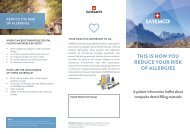SAREMCO Brochure | English | Without Classics | Digital Version
Explore SAREMCO Dental AG's comprehensive product brochure, showcasing our commitment to delivering high biocompatibility and exceptional functionality in dental care. As an independent Swiss company, SAREMCO Dental is renowned for its innovative solutions, including our industry-leading els extra low shrinkage materials for restorative dentistry and the cutting-edge saremco print range for 3D printing. Discover our full product range designed to meet the highest standards in modern dentistry, ensuring optimal patient outcomes and advanced dental restoration techniques.
Explore SAREMCO Dental AG's comprehensive product brochure, showcasing our commitment to delivering high biocompatibility and exceptional functionality in dental care. As an independent Swiss company, SAREMCO Dental is renowned for its innovative solutions, including our industry-leading els extra low shrinkage materials for restorative dentistry and the cutting-edge saremco print range for 3D printing. Discover our full product range designed to meet the highest standards in modern dentistry, ensuring optimal patient outcomes and advanced dental restoration techniques.
Create successful ePaper yourself
Turn your PDF publications into a flip-book with our unique Google optimized e-Paper software.
WELL-TOLERATED DENTAL FILLING MATERIALS
TOXICOLOGY AND ALLERGOLOGY OF
DENTAL PLASTIC MATERIALS
Dental materials should not only look good and last a long time, they should also be well-tolerated.
The growing interest in them has raised questions about the toxicology/biocompatibility of these materials.
Monomer and comonomer compounds are used in dental medicine, e.g. in composites and dentin adhesives. These
compounds as well as dental nanoparticles can also be released from these materials and end up in the human body
through resorption.
One important aspect in the evaluation of toxicology is the
determination of the resorption, distribution, metabolism
and elimination of a substance in an organism. Only resorbed
substances can cause harmful effects. Animal studies have shown
that the (co)monomers hydroxyethyl methacrylate (HEMA),
triethylene glycol dimethacrylate (TEGDMA) and bisphenol
glycidyl methacrylate (BisGMA) released from composites and
swallowed are completely resorbed and broken down into carbon
dioxide in the body. It has also been shown that intermediates are
produced during this metabolization that can have strong toxic
effects themselves – leading to “poisoning”. Formation of an
epoxy intermediate, 2,3-epoxy methacrylic acid has been seen
during the degradation of HEMA and TEGDMA in human liver
microsomes. Epoxy compounds are considered carcinogenic and
mutagenic.
For a scientifically supported risk analysis, it is important to know
how much of a substance will be released by a material, how
much is actually absorbed by the organism and when health
problems start manifesting in the organism. (Co)monomers
at most achieve “only” micromolar concentrations in human
saliva after elution from composite fillings. However, toxic
effects of these substances only start occurring in the millimolar
range. Nanoparticles released from nano-dental materials (e.g.
nanohybrid composites) could be detected during polishing,
which are primarily inhaled by dentists and dental staff. In
addition, after abrasion of this composite, the patient primarily
resorbs nanoparticles through the intestines after ingestion.
During in-vivo tests, pulverized nano-dental materials were not
more toxic than comparative materials. Silver nanoparticles in
dental materials do impact the polymerization of (co)monomers,
however. In a cytotoxicity test, nanoparticles were more toxic
than traditional titanium. However, a growing number of patients
have shown increased manifestations of adverse effects (e.g.
lichenoid reaction, asthma, eczema) after dental restoration. The
trigger of such reactions has now been conclusively identified as
methylacrylate, which is commonly used in dental medicine, e.g.
HEMA and TEGDMA.
Selection of the best-tolerated dental
materials for dental restoration
In continued research, the release rate of such substances was
determined for many of the commercially available composites,
adhesives and metal tooth materials. In collaboration with the
clinics at LMU Munich, allergy tests (www.dentaltox.com) were
developed to prove the presence of any existing allergies to
substances in dental materials. Patients with a proven allergy
to such substances should not receive dental materials that can
release these substances in the body. Today, it is possible after
allergy testing to select the best-tolerated dental material for the
patient in question before a planned dental restoration.
AT A GLANCE
• Statistics show that every 25th patient exhibits allergic
symptoms to dental materials. 1
• Within the group of (methyl-) methacrylate, HEMA and
TEGDMA are among those substances with the most
frequent sensitization. 2
• Dental staff has frequent and direct contact with these
substances in some circumstances and can therefore be
considered a risk group. 2
1
Prof. Dr. Dr. F.-X. Reichl, Outpatient Clinic for Conservative Dentistry and Parodontology,
Munich, Swiss Dental Journal 12-2014
2
«Biokompatibilität zahnärztlicher Werkstoffe” (“Biocompatibility of Dental Materials”),
G. Schmalz & D. Arenholt-Bindslev, Urban & Fischer 2005.
3
Images: With the kind permission of the Walther Straub Institute for Pharmacology and
Toxicology of the University of Munich
3
Prof. Dr. Dr. Franz-Xaver Reichl, LMU Munich
1. Image: Perioral dermatitis after application of a ceramic inlay with an adhesive 3
2. Image: Adverse effects of composite/adhesive applications in patients:
Lingua plicata (fissured tongue) and Lingua geografica (benign migratory glossitis) 3




